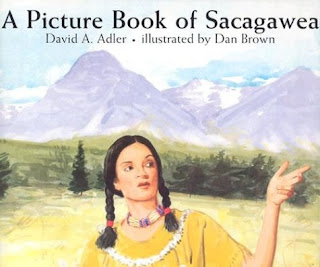 |
| Source: Google Picture Search |
Sacagawea was born in 1788 or 1789 to a Shoshone Native
American tribe that lived in the area of what is now the State of Idaho. Her
tribe was peaceful but were frequently attacked by enemy tribes. One day the
Hidatsa Tribe attacked her camp, killed her mother and many others. Sacagawea
was captured and taken to the Hidatsa Tribe in present day North Dakota as a
young girl.
Thus, she lived among the Hidatsa, but was their slave. She
was sold to a Canadian fur trapper named Toussaint Charbonneau at the age of
sixteen. Soon afterwards, Captains Meriwether Lewis and William Clark, along
with about “forty soldiers, frontiersmen, and boatmen, were sent by President
Thomas Jefferson to explore the Missouri River and find a route to the Pacific
Ocean.” Additionally, they were to draw maps, discover new vegetation and
wildlife, and learn more about the Native Americans (Adler, 2000).
The Lewis and Clark expedition arrived at the Hidatsa
camp, and hired Charbonneau as an interpreter, along with his wife Sacagawea,
who had a son in February of that year (1805). They soon set out to travel
through the North American western lands, in order to reach the Pacific Ocean,
which they did in November of 1805. Along the way, Sacagawea was a tremendous
help. Her knowledge of the plants and food that were edible prevented the
expedition from going hungry many times. They also passed through a Shoshone
camp, which turned out to be Sacagawea’s original tribe, as her brother was the
Chief.
The end of the journey was in August of 1806, when they
reached Fort Mandan, located in the Hidatsa Indian area. There Sacagawea, her
husband Charbonneau, and their infant son parted ways.
If it was not for the help from Sacagawea - as she knew the Shoshone
language well, was knowledgeable of the land and possessed much common sense
and strength - it is likely that the Lewis and Clark expedition would not have
been as successful as they were (Adler, 2000).
This book is a historical biography picturebook genre, and it has many
clear, colorful pictures in an acrylic painting technique that tell the story.
The words are easy to read and would be suitable for 1st through 3rd
grade. Before the reading of the book, a short lesson on Native American tribes
would be beneficial, as children may be vague on what role Native Americans
played in the western expansion of the United States. Additionally, after the
reading, each child could be required to write a one page paper on who the
President was at the time (Thomas Jefferson) and how American’s lived. This
book is an excellent learning tool to teach about Sacagawea who, along with her
infant son, helped assure the success of the journey and open up the continent
to the people of the United States” (Adler, 2000).
Reader Response
Questions
1. What was the name of Sacagawea’s infant son?
2. How far did the Lewis and Clark expedition
travel? Did they reach their goal?
When looking through the various library books in
order to choose one pertaining to this genre, the story of Sacagawea stood out
like a shining star amongst them all. She sacrificially gave everything to help
the explorers Lewis and Clark achieve their mission. Other versions tell the
story further that in appreciation for her service, Sacagawea’s son
Jean-Baptiste was adopted at the age of six by Clark, and given the best
education and care (Krull, 2015). Not much is written about her after the
expedition, but we do know that if she was not captured as a young girl and
brought to the Hidatsa camp, we would not have the story today of Sacagawea.
 |
| Sacagawea minted dollar gold coin in honor of her service to the United States Source: Google Picture Search |
References
Adler, D. (2000). A
Picture Book of Sacagawea. New York: Holiday House.
Krull, K. (2015). Women
Who Broke The Rules: Sacajawea. New York: Bloomsbury Children’s Books.
No comments:
Post a Comment